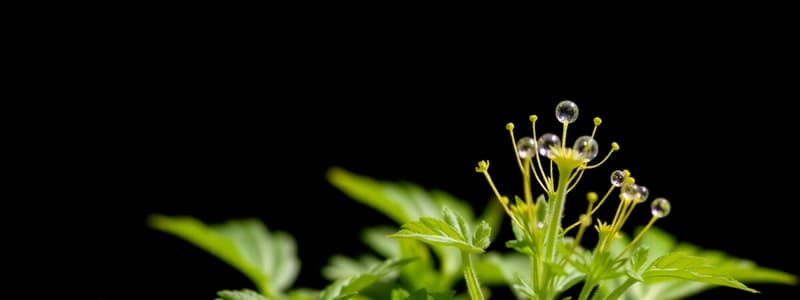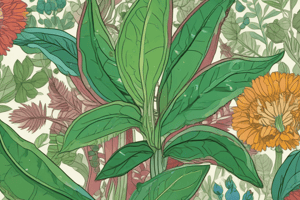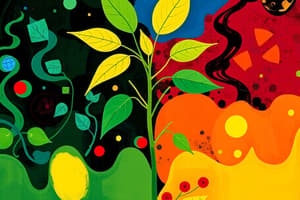Podcast
Questions and Answers
What percentage of the Earth's total biomass is made up of plant life?
What percentage of the Earth's total biomass is made up of plant life?
- 98% (correct)
- 75%
- 100%
- 50%
What is the primary source of energy used by plants in photosynthesis?
What is the primary source of energy used by plants in photosynthesis?
- Glucose
- Carbon dioxide
- Sunlight (correct)
- Water
What are the two main outcomes of photosynthesis?
What are the two main outcomes of photosynthesis?
- Production of oxygen and carbon dioxide
- Production of carbon dioxide and water
- Production of oxygen and glucose (correct)
- Production of glucose and water
Why are the activities of agriculture, cattle ranching, and mining considered a threat to rainforests?
Why are the activities of agriculture, cattle ranching, and mining considered a threat to rainforests?
What percentage of the Earth's land surface was once covered by tropical rainforests, and what percentage is it currently covered by?
What percentage of the Earth's land surface was once covered by tropical rainforests, and what percentage is it currently covered by?
What is the primary focus of botany?
What is the primary focus of botany?
Which of the following is NOT a step in the scientific method?
Which of the following is NOT a step in the scientific method?
What is the difference between an experimental group and a control group?
What is the difference between an experimental group and a control group?
What is the purpose of data analysis in the scientific method?
What is the purpose of data analysis in the scientific method?
What is a hypothesis?
What is a hypothesis?
What is the projected human population in 2030?
What is the projected human population in 2030?
Which of the following is NOT a way that plants are used in human society?
Which of the following is NOT a way that plants are used in human society?
What is the main reason for concern about the impact of human population growth on plant life?
What is the main reason for concern about the impact of human population growth on plant life?
What is the primary role of plants in the environment?
What is the primary role of plants in the environment?
What is one way that humans can reduce their impact on the environment?
What is one way that humans can reduce their impact on the environment?
What is a potential benefit of using plants to remove pollutants from the environment?
What is a potential benefit of using plants to remove pollutants from the environment?
What is a likely consequence of a significant decline in plant populations?
What is a likely consequence of a significant decline in plant populations?
Which of the following is NOT a plant product commonly used in human society?
Which of the following is NOT a plant product commonly used in human society?
Which of these disciplines focuses on the interaction of plants with their environments?
Which of these disciplines focuses on the interaction of plants with their environments?
What scientific discipline investigates the internal structure of plants?
What scientific discipline investigates the internal structure of plants?
Which field focuses on the practical uses of plants, especially by humans?
Which field focuses on the practical uses of plants, especially by humans?
Which discipline studies the inheritance of traits in plants?
Which discipline studies the inheritance of traits in plants?
Which of these is NOT a botanical discipline?
Which of these is NOT a botanical discipline?
Which discipline focuses on describing, naming, and classifying plants?
Which discipline focuses on describing, naming, and classifying plants?
Which of these is a key area of study in plant genetics?
Which of these is a key area of study in plant genetics?
What is the primary difference between "Plant Taxonomy" and "Plant Systematics"?
What is the primary difference between "Plant Taxonomy" and "Plant Systematics"?
What percentage of the world's food comes from plants?
What percentage of the world's food comes from plants?
What is the main way that redwood trees transport water to their upper leaves?
What is the main way that redwood trees transport water to their upper leaves?
Why are carnivorous plants important to the ecosystem?
Why are carnivorous plants important to the ecosystem?
Which of these statements accurately describes the relationship between humans and their environment?
Which of these statements accurately describes the relationship between humans and their environment?
How tall can redwood trees grow?
How tall can redwood trees grow?
What is the estimated human population size in 6000 B.C.?
What is the estimated human population size in 6000 B.C.?
Which of these statements best describes why plants produce both beneficial and harmful compounds?
Which of these statements best describes why plants produce both beneficial and harmful compounds?
Why is it critical to protect other species, besides humans?
Why is it critical to protect other species, besides humans?
Flashcards
Plant Biology
Plant Biology
The study of plants, their structure, function, and importance in ecosystems.
Photosynthesis
Photosynthesis
The process by which plants convert CO2 and H2O into glucose using sunlight.
Oxygen Released by Plants
Oxygen Released by Plants
Photosynthesis releases oxygen, critical for life on Earth; without it, oxygen would deplete rapidly.
Rainforest Coverage
Rainforest Coverage
Signup and view all the flashcards
Human Impact on Environment
Human Impact on Environment
Signup and view all the flashcards
Botany
Botany
Signup and view all the flashcards
Scientific Method
Scientific Method
Signup and view all the flashcards
Hypothesis
Hypothesis
Signup and view all the flashcards
Experiment
Experiment
Signup and view all the flashcards
Data Analysis
Data Analysis
Signup and view all the flashcards
Role of Plants
Role of Plants
Signup and view all the flashcards
Plants and Food Supply
Plants and Food Supply
Signup and view all the flashcards
Medicinal Drugs from Plants
Medicinal Drugs from Plants
Signup and view all the flashcards
Carnivorous Plants
Carnivorous Plants
Signup and view all the flashcards
Redwood Tree Height
Redwood Tree Height
Signup and view all the flashcards
Water Transport in Trees
Water Transport in Trees
Signup and view all the flashcards
Scientific Questions on Plants
Scientific Questions on Plants
Signup and view all the flashcards
Human Population Size
Human Population Size
Signup and view all the flashcards
Global Population Growth
Global Population Growth
Signup and view all the flashcards
Ways to Reduce Environmental Impact
Ways to Reduce Environmental Impact
Signup and view all the flashcards
Photosynthesis Importance
Photosynthesis Importance
Signup and view all the flashcards
Plant Products
Plant Products
Signup and view all the flashcards
Indirect Plant Consumption
Indirect Plant Consumption
Signup and view all the flashcards
Future of Plants and Society
Future of Plants and Society
Signup and view all the flashcards
Plant Products for Industry
Plant Products for Industry
Signup and view all the flashcards
Principle
Principle
Signup and view all the flashcards
Theory
Theory
Signup and view all the flashcards
Plant Anatomy
Plant Anatomy
Signup and view all the flashcards
Plant Physiology
Plant Physiology
Signup and view all the flashcards
Plant Taxonomy
Plant Taxonomy
Signup and view all the flashcards
Genetics
Genetics
Signup and view all the flashcards
Bioinformatics
Bioinformatics
Signup and view all the flashcards
Study Notes
General Botany Lecture - Chapters 1 & 2
- Plant life makes up over 98% of Earth's biomass.
- Photosynthesis converts carbon dioxide and water into glucose using energy from the sun.
- This process provides nutrients for other living things.
- Photosynthesis also releases oxygen; without plants, Earth's oxygen would be gone in about 11 years.
- Tropical rainforests originally covered 14% of Earth's land, but now only cover 6%.
- Human activities, including agriculture, ranching, and mining, lead to rainforest loss.
- Rainforests house roughly 50% of all species, including plants.
- Destroying rainforests negatively impacts all species and jeopardizes human survival.
- Plants provide 90% of the world's food.
- Plants are a source of vital medicinal and narcotic drugs.
- Some opioid drugs come from the opium poppy.
- Carnivorous plants consume small animals, gaining nutrients but not energy.
- Redwood trees in California can reach heights of up to 90 meters (300 feet).
- They efficiently transport water to their upper leaves using the sun's energy for water transport, a process called transportational lift, to support photosynthesis.
Botany as a Science
- Botany is the study of plants.
- Early botanical interest was predominantly practical, focusing on food production, fibers, fuels, and medicine.
- Over time, an intellectual interest in plants emerged, leading to botany developing as a science.
The Scientific Method
- The scientific method is a systematic approach to understanding the natural world.
- It involves formulating a question, creating a hypothesis, conducting experiments, and developing a theory.
Hypotheses
- A hypothesis represents a tentative, testable explanation for an observation.
Experimentation
- An experiment is a controlled test to evaluate the validity of a hypothesis.
- Experiments must be repeatable.
- They involve variables, which can be changed or held constant.
- A scientific experiment uses both a control group and an experimental group.
Data Analysis
- Data analysis involves processing the results from an experiment.
- Data analysis can lead to the development of principles and theories.
- Principles are useful generalizations derived from experimental data.
- Theories group related principles together.
Diversification of Plant Study (Botanical Disciplines)
- Plant Anatomy: Studying the internal structure of plants.
- Plant Physiology: Examining plant function.
- Plant Taxonomy: Classifying and naming plants.
- Plant Systematics: Developing methods for classifying and naming plants.
- Plant Geography: Studying plant distributions.
- Plant Ecology: Investigating interactions between plants and their environments.
- Plant Morphology: Analyzing the form and structure of plants.
Additional Botanical Disciplines
- Genetics: Studying heredity and potential improvements in agriculture, medicine, and other areas.
- Genetic engineering: Transferring genes between organisms.
- Genomics: Focusing on genes and their functions.
- Bioinformatics: Combining biology, statistics, and computer science to analyze DNA and RNA.
More Botanical Disciplines
- Cell Biology: Examining the structure and function of plant cells.
- Economic Botany and Ethnobotany: Studying the practical uses of plants and plant products, especially how people use them.
Human Impacts on the Environment
- Human activities like draining wetlands, clearing vegetation, dumping waste, and using pesticides affect the environment.
Ways Humans Can Reduce Their Environmental Impact
- Humans can reduce their environmental impact through changes in agricultural practices, removing pollutants, recycling, using biological pest control, conserving water and energy, and preserving habitats.
Human and Animal Dependence on Plants
- Plants convert the sun's energy to a usable form for plants and animals (chemical bond energy).
- This process also produces oxygen and eliminates carbon dioxide, essential for our breathing.
- Essentially, all food and beverages originate directly or indirectly from plants.
Plant Products in Human Society
- Plants are a source of food, perfumes, dyes, adhesives, food stabilizers, beverages, lumber, paper, and coffee.
More Plant Products
- Plants also provide clothing, medicines, coal, oil, and alternative energy sources.
Plants and the Future
- Plants are vital for food, shelter, and clothing needs of a growing human population.
- Plants can play a role in removing pollutants from the environment.
- Plant habitat destruction should be minimized.
Studying That Suits You
Use AI to generate personalized quizzes and flashcards to suit your learning preferences.



